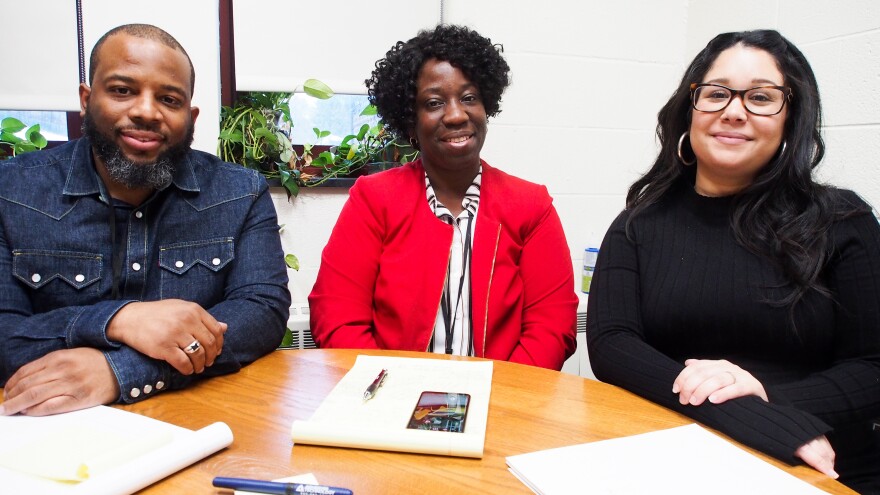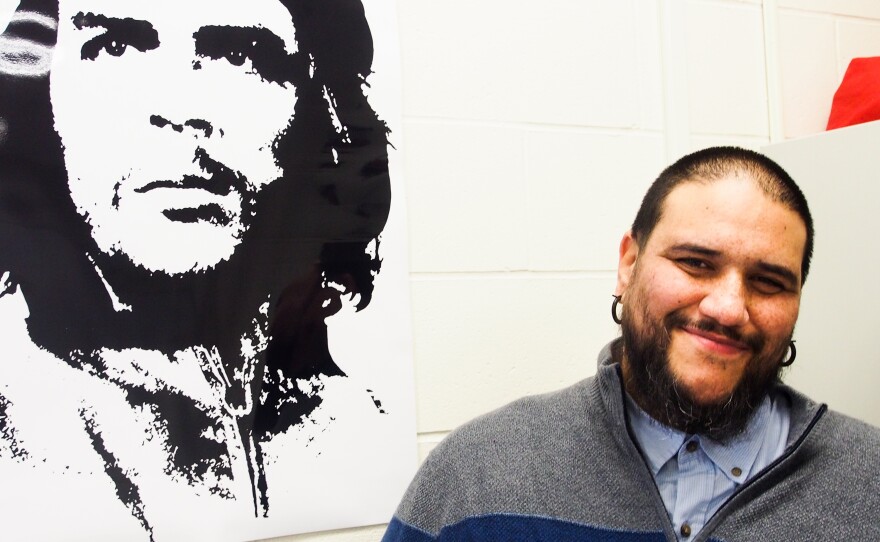Depending on their district and available technology, students find themselves with varying levels of daily work to do from home while schools are closed. The disruption in western Massachusetts has no doubt complicated efforts to address a major inequity.
Studies show there are numerous barriers black and Latino college students face in becoming certified K-12 teachers. Several districts in western Massachusetts have been partnering with an organization that helps teachers’ aides complete their education to become full-fledged teachers.
During third period in Danilo Ferro’s classroom at Amherst Regional Middle School, he moved about the room checking on one eighth-grader after another.
One student munched on a snack, listened to music, and typed on a laptop all at the same time.
Ferro, a special education math teacher, leaned in close to the screen.
“Draw four points first that are on the smaller circle,” he said, watching as the child moved the cursor. “Nice. And then call it E.”
There were nine or 10 students in the room, each doing individual work, each requiring a different strategy for helping them to succeed.
Ferro can be calm, animated, firm. He is definitely patient. And for some students, he said, it’s of huge importance that he’s Latino, an immigrant, that he has an accent.
“I am the first math teacher in their life who is a person of color,” Ferro said.
Originally from Brazil, Ferro speaks English, his native Portuguese, and what he describes as slow Spanish.
“What does it say in Spanish here?” he asked a boy at a corner cubicle. Then Ferro read aloud: “Marca los puntos de intersección de los rayos.”
The nationwide shortage of teachers of color is on full display in Amherst, Northampton and Holyoke. In each of these districts, there’s a significant gap between the percentage of students of color and the percentage of teachers of color.
That gap is widest in Holyoke, where the share of students of color exceeds teachers of color by 63%. The gaps in Amherst and Northampton are 25% and 23%, respectively.
Studies have found students of color benefit a number of ways from greater teacher diversity.
Jose Bou, equity manager at Holyoke Schools, said white students need diverse teachers, too.
“Listen, if students aren't prepared to have a female boss — if they're not ready to have a black boss, if they're not ready to have a Latino boss — they're not going to make it,” Bou said.
Ferro didn’t start out with a plan to teach, but after a year as a translator in Amherst Schools, he became a para, or paraprofessional teacher. Most often, the job means working one-on-one as a support person for children with special needs.
Public schools couldn’t run without paras. It’s a sometimes rewarding, often demanding job. Their salaries are much lower than teachers’. There’s a high burnout rate.
So when an organization called Paradigm Shift teamed up with Amherst schools and offered to help Ferro become an accredited teacher, he went for it.
“You get a lot more responsibility,” Ferro said, and laughed. “You also get a decent salary.”

Through Paradigm Shift, paras complete their bachelor’s and master’s degrees while continuing to teach in the same school. The program also assists paras in passing their licensure exams.
Low pass rates on those tests for students of color recently led state education Commissioner Jeffrey Riley to propose significant changes to licensure requirements.
Paradigm Shift director Marla Solomon said her program is designed to serve exclusively paraeducators of color.
“The role itself of being a para is already sort of second class in the system,” Solomon said. “And if you're a person of color who's a para in a largely white teaching environment, that adds an extra dynamic to it.”
Ferro is among the first cohort to come through Paradigm Shift. He’ll receive his accreditation from Mount Holyoke College later this year.
There are currently about 30 paras in the program in Holyoke, Amherst and Springfield. Northampton is preparing to start its first para in the program this year.
“Paradigm Shift is wonderful,” Ferro said as he surveyed his classroom. “And there's a lot of great things being done here. But we can't be naive that these alone can solve the problem.”
Ferro said public schools have been charged with fixing societal problems that go far beyond teaching arithmetic or helping kids identify points on a coordinate plane. Many of his special education students are kids of color, he said, and their difficulties aren’t limited to learning disabilities.
“They're having a hard time finding themselves as part of society,” he said.
Part of his job, Ferro said, is to help his students see themselves as protagonists of social change. That’s a lot to expect of a math teacher, and it points to one of the biggest challenges administrators face as they attempt to increase the diversity of their workforce: How do schools support their teachers of color, in order to assure those teachers want to stay on the job?
“Teachers that I talked to all over the state — and in Northampton — who are educators of color are feeling isolated,” said Tom Chang, a fifth-grade math interventionist at Jackson Street School in Northampton. He’s Asian American, and he described the covert and explicit ways teachers of color are marginalized in their schools.
“When things happen, either microaggressions or outright acts of racism — or [when teachers] see the ways in which kids are being hurt by racism — there doesn't really feel like there's a community outlet to reflect on that or to talk about that or to deal with that,” Chang said.
National trends show a lower retention rate for teachers of color, resulting from low pay, high burnout in under-resourced urban schools, and more attractive opportunities in other professions.
Norman Pacheco, a Chicano and Native American teacher, said he left Northampton schools for Holyoke in part so he could have an influence on more students of color. It didn’t hurt, he said, that Holyoke offered a significant bump in salary.
“Northampton is saying all the right things,” Pacheco said. “But really, you can't expect to recruit people when wages are as low as they are.”
Administrators in all three districts note the importance of creating a more supportive school culture for their teachers of color. This takes attention and a will to change established norms.
Stephen Mahoney, principal of Holyoke High, pointed to one reason enacting such changes can be difficult.
“One of the most dangerous things about becoming a teacher is that you became a teacher because you were good at school,” Mahoney said. “Then you have all these people who are teaching who are good at the way school was already, so why should we change the way school is?”

Doreen Cunningham, Amherst's assistant superintendent of diversity, equity, and human resources, said it’s up to school leaders of all races to pay attention to what their teachers of color are experiencing. One opportunity is the principal training Amherst holds every year, where they offer strategies on staff retention.
“So this year, we did a circle within a circle,” Cunningham said. “And we had staff of color sit there and talk about their experiences in our district. And they weren't so good, right? And so the principals had to sit there on the outer circle and own it.”
School leadership creates school culture, and the culture of a school determines whether its teachers — and its students — feel they belong there.
“If I'm a student and I wasn't treated nicely,” Cunningham said, “I definitely do not want to step foot in a school building after my senior year.”
Despite all the real and complex challenges to diversifying the teacher workforce, it’s a fairly simple equation. If schools want more teachers of color, Cunningham said, schools need to treat their students of color better.
“If we're not doing that, then we're telling them, we don't need teachers of color. We don't need you guys,” Cunningham said.
The teacher pipeline doesn’t start after high school graduation. In Amherst, Northampton, Holyoke and districts across the country, schools are making — or not making — their future teachers right now.
This is part three of a series. Catch up with part one and part two.






